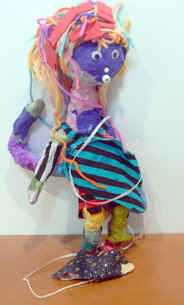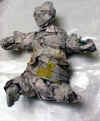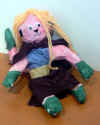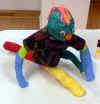|

Student Project |
|
|
Supplies
and Materials
-
Wallpaper
Paste
-
White
School Glue
-
1"
Bristle Utility Brushes (Optional)
-
Paper
cups, small buckets for glue
-
12
Gauge Steel Wire (or any relatively stiff wire.
-
Wax
Paper or Freezer Paper
-
Newspaper
-
Strips
of cardboard or craft sticks
-
Colored
Pipe Filters
-
White
Paper Towels
-
Colored
Tissue Paper
-
Google
Eyes
-
Foam
Construction Paper
-
Various
Notions
-
Scrap
Materials
|
|

Student Project
|
|

Student Project
|
|
Session One (one hour,
including clean up time)
|

Wire Armature:
|

Wire Armature showing S-Curves
|

Dry Wrapped Structure
|
|
-
Have students write their names on the freezer
paper. An 18" piece will accommodate most projects. It is not
too early to emphasize the necessity of working on the shiny side of
the paper -- glue doesn't stick to this surface, normally.
-
Wire Armature
-
Cut one 18" to 24" section of the 12
gauge wire (the head and body) and two 12" sections (the
arms and legs)
-
Have students make a loop at the top of the
longer piece of wire. This will hold the head.
-
Have students make shoulders and hips by making S-curves
in the remaining part of the long piece of wire. Squeeze these S-curves
tight to make T-shape.
-
By weaving the arm and leg section through the T-shapes,
twisting the wire, and taping, secure the wire sections
together. (See photo: Wire Armature)
-
Leave limbs long for spider monkeys, for shorter
limbed primates fold wire up and twist together. A quicker
solution that cutting each students piece to their specifications.
-
Dry Wrapped Structure
-
The Head: Have students crumple newspaper to
make a ball. Place crumpled ball (depending on the
desired size of the head, made from one sheet or multiple sheets)
into the center of another sheet, wrap together and secure with
masking tape.
-
The Arms & Legs: Crumble
newspapers (this makes the paper softer, easier to work with,
and more receptive to the glue.) Uncrumble paper, smooth flat
and then roll paper into long tubes. Twist these tubes to make
snake-shapes, similar to coils in clay. Tape the ends and a few
spots in the middle to keep the coil-shapes from untwisting. Now
take the coil and tape to the end of one hand. At a few
points tape along the arm, up to the neck. Wrap like a
scarf around the neck space and then onto the body section,
secure with tape. Advanced and fast-working students may
twist the section around the wire rather than just following the
wire up the arm. Use the same procedure for remaining limbs.
-
The Body: Much of the body has been
formed by the remainder of the limbs, but more shaping can be
done by either taping wrapped coils around the body or by taping
balls of newspaper to the chest or stomach. If too much tape is
used there will be little exposed newspaper to hold the glue
(the glue and tape are not really compatible). To remedy
this problem, the body can be wrapped with a sheet of paper and
secured with as little tape as necessary. This is also a
solution for overly bumpy structures.
-
Collect projects and store till next session. Keep
the insect and the freezer paper together.
|
|
 Dry
Wrapped Structure
This has legs and arms shortened by folding the wire
up and twisting it together. It will become a baby gorilla.
|
|
Session
Two: (one hour, or combined with the first session about an hour and
half)
-
At least 30 minutes before class, mix the
wallpaper paste to a thick consistency, 1box for 15 to 20
students. Adding a cup of white glue (PVA) will make a
stronger bond.
-
Return projects to students and give each student a
cup of wallpaper paste/glue (for neatness, don't fill), a utility brush, and a
section of newspaper.
-
Show how to tear the newspaper into strips. Hold
full sheet of paper, as reading, and tear downward. A rather clean,
straight tear will result. Stress that perfection in tearing is
not that crucial to the final project, but that the skill makes
things easier.
-
Once the newspaper is torn into long strips, have
students tear into smaller sections -- about the length of their
hands. (1 1/2" x 3" strips are about average, sometimes
longer or shorter as needed.)
-
Have students brush the entire animal, top and
bottom, with the wallpaper paste. Mentioning how "slimy"
the glue is before the students discover this fact on their own,
defuses most reluctance to get it on their hands.
-
There are several way to apply the glue and strips
of paper.
|

Crossing pattern for strips of newspaper |
|

Tip wrapping for
hands and feet
(Gloves and socks) |
-
Brush on glue, apply strip, brush glue over
strip. Glue. Strip. Glue. Cross-Strip. Emphasize
that two pieces of paper cannot be stuck together without a
layer of glue. Crossing or weaving applications work
best. If one piece is laid vertical, then the next piece
is laid horizontal. Working from tips (ends) toward the
center is best. (The neatest method). Tell them to put
the socks and gloves on first, by covering the tips and
folding the rest of the strip up to the wrist area. Then
wrap the wrist with another strip.
-
Smear the glue on with the hands and then
applying the strips. (The best for shaping fun forms, but
dries slowly and is very messy.)
-
Dip the strips in the glue and squeeze off
excess glue by pulling strips between gently closed
fingers. (Most pliable paper, reflects the form
underneath. Medium messy.)
-
Encourage students to apply a complete coat and then
another. The more coats (layers) the stronger the animal's
hide will be. In some cases I alternate newspaper and paper towels
to show how many layers.
-
For the final layer, pass out white paper towels, tear into strips and
apply just like newspaper. This is a substitute for white
gesso. It gives the project a white surface so that the
transparent tissue paper can cover it.
-
Collect the project: Animal and freezer paper. Let dry
two days if possible -- a hair dryer can be used to speed up
process. Good ventilation is important.
-
If time is left explain how artists share and improve
on ideas. No one should feel like someone else has taken their
idea. Have students take turns talking about decorating their
primate and what their animals might be doing. Explain that
some students will want to create realistic monkeys and others very
fanciful. I mention ideas like: tutus, high-heels, gloves,
helmets, belts, hats, boots. Also, race car drivers, doctors,
astronauts, basketball players, and fashion models. After that the
students suggest things like: skateboard chimp, marmoset doctor, warrior
gorilla, chunky monkey teacher.
|
|

Student Project
This shows a wet project with the white paper towel. Notice
that the newspaper will show through the paper towel as long as it is
damp.
|
|
Session
Three: (Half Hour)
-
Pass out projects, glue and brushes.
-
Tear color tissue paper sheets into
quarters. (Smaller sheets result in less waste.) Let students
have three sheets of their choice color. Encourage thinking
about patterns and textures, and explain that light colored bodies
will show darker patterns.
-
Note: a few layers of white
tissue paper, applied just like the newspaper strips, make a
better surface. Depending on the speed of the class, this can be
used.
-
Have students tear tissue into strips
and then apply like the newspaper strips. Glue. Strip. Glue.
Cross-strip. Glue.
-
Apply patterns in contrasting colors
or tones of torn paper. Some students will want to cut their pattern
shapes with scissors, this is okay, but I explain that the natural
edges are more interesting.
-
Collect projects. Let dry for two
days if possible. If the previous session is dry, then one day
is normally enough.
-
If time is left, pass out drawing
paper and markers and have students draw where their animals live
(encouraging realism or fantasy) and try to get them to express a
feeling of time (morning, noon, afternoon, night, winter, summer,
fall, or spring.
|

Student Project
|
|

Student Project
|
|

Student Project
|
|
| Session
Four:
(Half hour) + a lot of clean-up
(This session is the most variable -- some students take almost no
time and others are able to work for hours. Helping each other and
assigned clean-up activities can solve part of this problem.)
-
Prepare room by setting up work stations.
Beads, buttons, google eyes in one area. Construction papers and
construction fun-foams in
another. Pile of material scraps in another. Pipe
cleaners, craft sticks. Yarns, strings, ribbons. Pom-poms,
bric-a-brac, and found objects.
-
Each students' table should have scissors and
glues.
-
Pass out projects. Have few students to talk about
their plans, this will get the creative juices going.
-
Tell them that they may get up and select items on
their own and get out of the way. This session is what it is
all about.
|
|